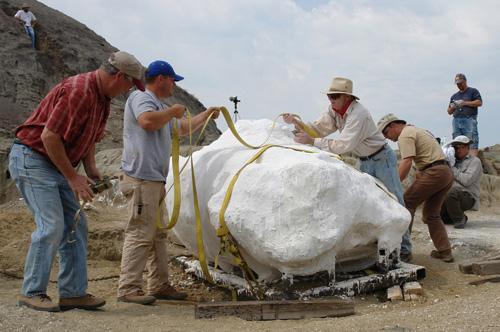Dinosaur ‘mummy’ uncovers secrets to paleontologists

In an undated photo, scientists from the University of Manchester and excavation team members prepare to move the dinosaur mummy. Phillip Manning, The Associated Press
Dec 3, 2007
Last updated on May 12, 2016 at 07:14 p.m.
WASHINGTON – One of the most complete dinosaur mummies ever found is revealing secrets locked away for millions of years, bringing researchers as close as they will ever get to touching a live dino.
The fossilized duckbilled hadrosaur is so well preserved that scientists have been able to calculate its muscle mass and learn that it was more muscular than thought, probably giving it the ability to outrun predators such as T. rex.
While they call it a mummy, the dinosaur is not really preserved like King Tut was. The dinosaur body has been fossilized into stone. Unlike the collections of bones found in museums, this hadrosaur came complete with skin, ligaments, tendons and possibly some internal organs, according to researchers.
The study is not yet complete, but scientists have concluded that hadrosaurs were bigger and stronger than had been known, were quick and flexible and had skin with scales that may have been striped.
Get The Daily Illini in your inbox!
“Oh, the skin is wonderful,” paleontologist Phillip Manning of Manchester University in England rhapsodized, admitting to a “glazed look in my eye.”
“It’s unbelievable when you look at it for the first time,” he said in a telephone interview. “There is depth and structure to the skin. The level of detail expressed in the skin is just breathtaking.”
Manning said there is a pattern of banding to the larger and smaller scales on the skin. Because it has been fossilized researchers do not know the skin color. Looking at it in monochrome shows a striped pattern.
He notes that in modern reptiles, such a pattern is often associated with color change.
The fossil was found in 1999 in North Dakota and now is nicknamed “Dakota.” It is being analyzed in the world’s largest CT scanner, operated by the Boeing Co. The machine usually is used for space shuttle engines and other large objects. Researchers hope the technology will help them learn more about the fossilized insides of the creature.
“It’s a definite case of watch this space,” Manning said. “We are trying to be very conservative, very careful.”
But they have learned enough so far to produce two books and a television program. The TV special, “Dino Autopsy,” will air on the National Geographic channel Dec. 9. National Geographic Society partly funded the research.
A children’s book, “DinoMummy: The Life, Death, and Discovery of Dakota, a Dinosaur From Hell Creek,” goes on sale Tuesday and an adult book, “Grave Secrets of Dinosaurs: Soft Tissues and Hard Science,” will be available in January.
Soft parts of dead animals normally decompose rapidly after death. Because of chemical conditions where this animal died, fossilization – replacement of tissues by minerals – took place faster than the decomposition, leaving mineralized portions of the tissue.





